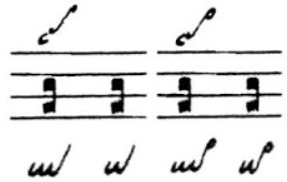I posted this question on Wikipedia a year ago, with no answers. These two musical signs look eerily similar.
- The Baroque Schleifer or slide (see Wikipedia page):
- The quilisma in Gregorian chant (see French Wikipedia page):
Coincidentally, their performance is nearly identical. The Gregorian quilisma is now known to have been originally sung as a quick sliding glissando or portamento towards a higher note, or, equivalently, as a quick rising grace or passing tone towards that note.
In the picture above, the two signs above the staff are the quilisma as it appears in ninth-century Laon/Lorraine/Metz notation of Gregorian chant, where it is depicted as a medieval question mark ('?' upside-down) to indicate the rising of the voice.
The four signs below the staff are the quilisma in ninth- and tenth-century St. Gall notation. I highly suspect this is the ancestor of the Schleifer sign, on account of
- identical shape,
- identical performance, and
- St. Gall notation being regional to Germany and Switzerland at the end of the first millennium.
Could this be a pure coincidence? Is it possible to conclude from any evidence a true ancestral relationship here? Do we have samples of similar signs used in music between 1100 and 1600 that could suggest so?
Do we have samples of similar signs used in music between 1100 and 1600 that could suggest a continuity of the symbols' application?




